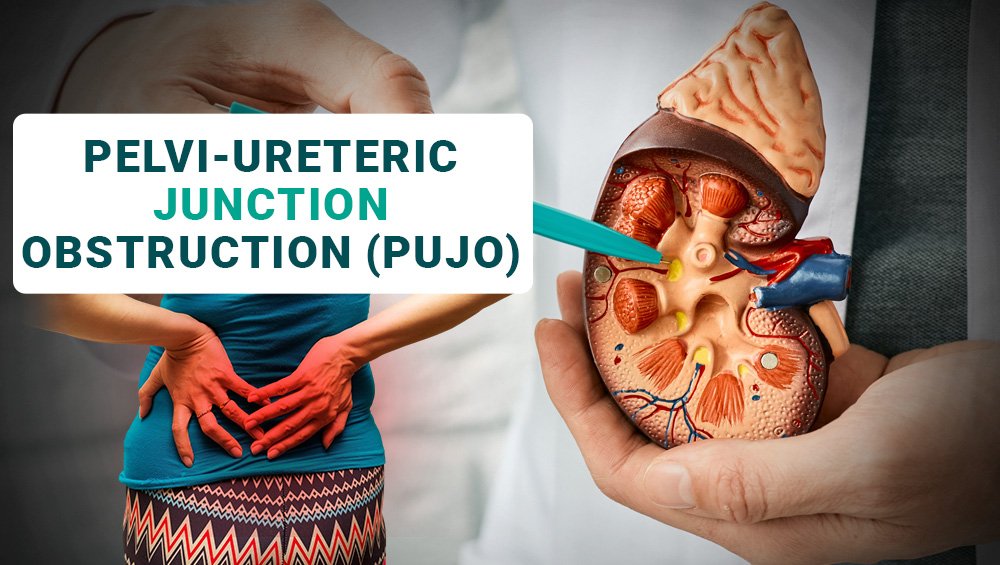Kidney problems are often hidden until they cause pain or discomfort such as PelviUreteric Junction Obstruction. The PUJO abbreviation is used to describe a blockage at the junction of the ureter and the kidney which is the tube carrying urine to the bladder. This narrowing or blocking can cause the urine to not flow correctly, causing swelling in the kidneys and even stone formation.
In some cases, a pelviureteric junction calculus can make the problem worse. If left untreated, PUJO can cause repeated infections, pain and even kidney damage. The good news is that with today’s advanced treatments and PUJO can be managed effectively. With Dr. Anuj Arora, the Best Urologist in Noida, patients get safe, modern and personalized care.
What is PUJO?
PUJO which is an acronym for Pelvi-Ureteric Junction Obstruction derives its name from its nature of being an obstruction of the pelvi-ureteric junction which is the junction of the kidney and the ureter (the ureter is the conduit that transmits the urine from the kidney to the bladder).
If this junction is constricted or blocked, the upstream urine is also constricted and subsequently blocked which causes the kidney to swell (kidney obstruction, hydronephrotic kidneys) and sometimes even stones.
Some patients develop a PUJ calculus (a stone lodged in the PUJ), further aggravating the obstruction.
Symptoms of PUJO
The signs of PUJO can vary as some people don’t feel anything until the condition worsens. But common symptoms include:
- Loin or back pain – sometimes located on one side particularly after drinking excessive amounts of water.
- Recurrent urinary tract infections (UTIs) – recurrent infections may suggest inadequate urine flow.
- Nausea and Vomiting – may be caused by inflammation and renal stones.
- Blood in urine (hematuria) – can be seen or found during investigations.
- Kidney stones – decreased urinary output raises the chances of stasis.
- Enlargement of the kidney (hydronephrosis) swelling – most commonly seen in ultrasound.
Causes of PUJO
PUJO can happen in both children and adults. Sometimes, it is present since birth (congenital), while in other cases, it develops later in life. The main causes include:
- Narrowing at birth – some people are born with a naturally tight pelvi-ureteric junction.
- Crossing blood vessels – a blood vessel pressing on the ureter can block the flow of urine.
- Scarring or injury – previous surgeries, infections, or trauma can cause scar tissue that narrows the junction.
- Stones – a pelvi-ureteric junction stone or pelviureteric junction calculus may get stuck at the junction, blocking urine.
- Recurrent infections – repeated UTIs can damage the area, leading to obstruction.
Diagnosis of PUJO
Diagnosing Pelvi-Ureteric Junction Obstruction usually starts with a doctor understanding your symptoms and doing a physical examination as to confirm the condition and see how much the kidney is affected.
A few tests may be suggested:
- Ultrasound – it is a simple and painless scan that shows if the kidney is swollen.
- CT Urography / CT Scan – it gives a detailed picture of the urinary tract helps detect narrowing and can also show if a stone i.e. pelviureteric junction calculus is present.
- Nuclear Renal Scan (DTPA/MAG3 scan) – checks how well the kidneys are working and measures the blockage level.
- Urine and Blood Tests – help look for infections, kidney function or any other related issues.
Pelvi-Ureteric Junction Management
Treatment for PUJO depends on the severity of obstruction and whether a stone is present. Options include:
- Observation: For mild cases without symptoms.
- Endoscopic Procedures : This is a minimally-invasive technique that can be used to remove a calculus at the pelviureteric junction or relieve obstruction.
- Laparoscopic/Robotic Pyeloplasty is the gold standard for PUJO. It reconstructs the narrowed joint, ensuring smooth flow of urine and preserving kidney functions.
Why Pick Dr. Anuj Arora – Best Urologist in Noida
It is vital to consult an authority when it is about ailments like PUJO. Dr. Anuj Arora is recognized for his:
- Knowledge in intricate endoscopic and laparoscopic techniques for their urology conditions.
- Customized methods of intervention for every individual.
- Remarkable outcomes in PUJO and renal calculi surgeries.
- Caring and gentle treatment.
Conclusion
Living with Pelvi-Ureteric Junction Obstruction can be uncomfortable and worrying but it doesn’t have to affect your quality of life. PUJ Obstruction Treatment often causes pain, infections or stones yet many people delay treatment because they don’t realize how simple and effective modern options are. Whether the problem is due to a congenital blockage or a pelviureteric junction calculus and treatments today are minimally invasive, safe and highly successful.
With the right care, kidney function can be preserved and symptoms can be completely resolved. If you notice repeated flank pain, blood in urine or frequent infections, don’t ignore it. Consult Dr. Anuj Arora who have 8+ years of experience and is the best Urologist in Noida for advanced PUJO treatment and long-lasting relief.









